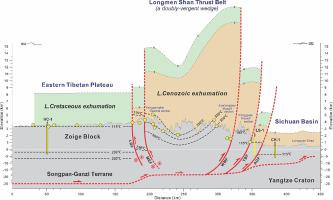Earth-Science Reviews ( IF 10.8 ) Pub Date : 2023-01-13 , DOI: 10.1016/j.earscirev.2023.104319 Zhiwu Li , Peter J.J. Kamp , Shugen Liu , Ganqing Xu , Kui Tong , Martin Danišík , Zijian Wang , Jinxi Li , Bin Deng , Bo Ran , Yuehao Ye , Wenhui Wu

|
The current structural model for the Longmen Shan (Mountain) belt, which is peripheral to the Eastern Tibetan Plateau, is an asymmetric orogenic wedge with a series of northwest-dipping listric thrust faults that sole-out into a sub-horizontal mid-crustal level detachment. Current debate, stemming from newly published data about the metamorphic petrology of greenschist and higher-grade basement rock facies within the Longmen Shan, coupled with numerical ages, centers around how exhumation of this margin has been partitioned into Cretaceous versus Late Cenozoic components. Here we report extensive new low-temperature thermochronology data for samples across the margin obtained from four vertical sections, one in outcrop and three in deep (6–7 km) drill-holes (including drill-hole HC-1 on the plateau), and interpret them, together with comparable data published for another two steep vertical sections in outcrop (Xuelongbao and Pengguan massifs). The results highlight the disrupted paleo-thermal structure of the upper crust underlying the margin, from which we map in space and time two episodes of exhumation, one during the Late Cretaceous (~90–70 Ma), and the other during the Late Cenozoic (~27 Ma – present day). Some 80% of the total exhumation occurred during ~27–0 Ma and the balance during ~90–70 Ma. A new feature in the distribution of Late Cenozoic exhumation across the margin is the surprisingly large amount southeast of the Longriba Fault System (LFS), which is located immediately east of the high plateau. This new component of exhumation diminishes the asymmetric character of the current structural model of the margin. We interpret the LFS as southeast dipping back-thrusts to the northwest dipping listric thrust faults within the eastern Longmen Shan. We therefore conclude that the Longmen Shan Thrust Belt is a doubly-vergent orogenic wedge peripheral to the Eastern Tibetan Plateau.
中文翻译:

晚白垩世 - 青藏高原东部边缘的新生代热结构和折返:双辐造山楔
位于青藏高原东部外围的龙门山(山)带的当前构造模型是一个不对称的造山楔,具有一系列西北倾的斜坡逆冲断层,这些断层延伸到亚水平的中地壳水平分离。目前的争论源于关于龙门山内绿片岩和高品位基岩相的变质岩石学数据,再加上数值年龄,围绕着该边缘的折返如何划分为白垩纪和晚新生代组分展开。在这里,我们报告了大量新的低温热年代学数据,用于从四个垂直部分获得的边缘样本,一个在露头中,三个在深(6-7 公里)钻孔(包括高原上的钻孔 HC-1)中,并诠释它们,以及另外两个露头陡峭垂直剖面(雪隆堡和彭关地块)的可比数据。结果突出了边缘下方的上地壳被破坏的古热结构,从中我们在空间和时间上绘制了两次折返,一次发生在晚白垩世(~90-70 Ma),另一次发生在晚新生代(~27 Ma - 现在)。约 80% 的总折返发生在 ~27-0 Ma 期间,其余发生在~90-70 Ma 期间。晚新生代在陆缘折返分布的一个新特征是位于高原东部的龙日坝断层系统 (LFS) 东南部的数量惊人。这种新的折返组成部分削弱了当前边缘结构模型的不对称特征。我们将 LFS 解释为东龙门山内的东南倾向逆冲向西北倾的斜坡逆冲断层。因此,我们得出结论,龙门山冲断带是青藏高原东部外围的双辐造山楔。











































 京公网安备 11010802027423号
京公网安备 11010802027423号